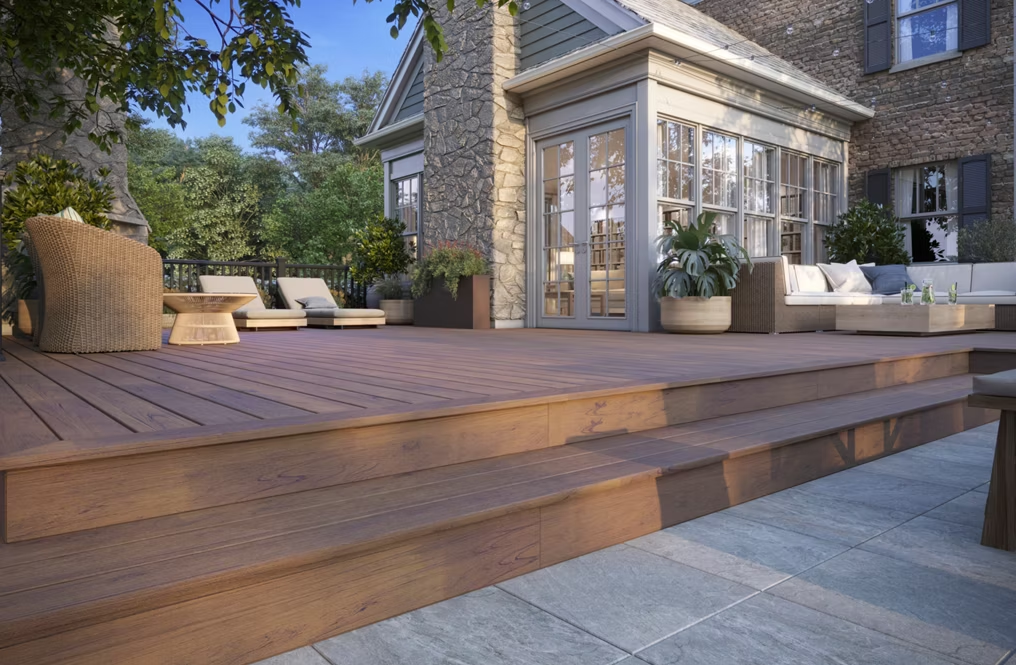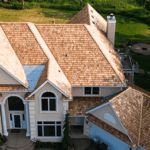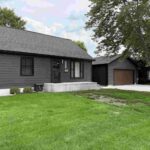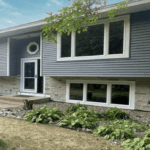Not all home renovations are entirely rewarding. It’s hard to actually enjoy or “use” a new roof. But adding or replacing a deck on your home is one of the most rewarding investments you can make. It’s where barbecues happen, morning coffees are enjoyed, and great memories are made. But before you can start planning your deck installation, there’s one important decision to make: wood or composite?
At Legacy Construction, we’ve built decks of all shapes and sizes across Minnesota. We know there’s no one-size-fits-all solution, which is why we’re here to help you weigh your options and choose the material that best fits your home, lifestyle, and budget.
Understanding the Cost Difference
One of the first questions most homeowners ask is, “How much does a deck cost?” The truth is that your total investment can vary depending on the material you choose.
Wood decking tends to be more budget-friendly upfront, but even this can quickly change depending on the current market price of the wood you use. However, it’s important to remember that the initial savings can come with higher costs down the road. Wood requires regular staining, sealing, and sometimes even repairs due to weather-related wear.
Composite decking, on the other hand, comes with a higher initial price tag. Brands like Trex® or TimberTech® cost more per square foot, but they’re designed for the long haul. Since composite boards don’t need to be stained, sealed, or replaced as frequently, many homeowners find the investment pays off over time through reduced upkeep and increased longevity.
Speaking of Maintenance: How Much Work Do You Want?
Wood and composite offer very different experiences when it comes to upkeep.
Natural wood demands consistent maintenance. Expect to clean it regularly and reapply stain or sealant every few years. Without this care, wood decks can fade, warp, or rot, especially in Minnesota’s freeze-thaw climate.
Composite decking was designed to eliminate many of these headaches. Made from a mix of recycled wood fibers and plastics, composite boards resist mold, rot, insects, and UV damage. You won’t need to worry about sanding or staining. Just a quick wash with soap and water now and then will keep your deck looking great.
If you enjoy hands-on home projects and don’t mind the seasonal upkeep, wood may not be a burden. But if you’d rather spend your weekends enjoying your deck than maintaining it, composite might be a better fit.
Comfort and Feel Underfoot
While appearance and durability are important, don’t overlook how the deck feels when you’re actually walking on it.
Wood offers a natural texture and tends to stay cooler underfoot in direct sunlight. It’s a great option if your deck gets a lot of sun exposure, especially for barefoot use in summer. However, over time and without regular maintenance, wood can develop splinters, cracks, or raised edges.
Composite decking has a smooth, splinter-free surface, which makes it comfortable for families with kids or pets. Some composite boards can get warmer in hot sun, particularly darker colors, but many newer products are designed with heat-reducing technology to help manage surface temperature. If comfort and safety are top priorities, especially for households with young children or elderly family members, composite offers a reliably smooth and even surface.

Lifespan and Durability
A deck isn’t something you want to replace every 10 years. Choosing a material that lasts, especially in a climate like ours, where snow, ice, and humidity can be harsh on outdoor materials, is definitely something you want to consider.
With proper care, cedar and many other types of wood can last 20–25 years, and tropical hardwoods can sometimes go 30+ years. Remember that consistent, meticulous maintenance is required to get this lifespan.
Composite decking is built to last. Most composite brands can last 25 years or more, and many installations hold up beautifully for decades with minimal upkeep. The boards won’t crack, splinter, or warp the way natural wood can. If durability and longevity are at the top of your priority list, both options will last a good amount of time.
The Look and Style of Your Deck
Both wood and composite offer attractive options, just in different ways. Wood is naturally beautiful and rich in texture. Each board is unique, with grain patterns, knots, and colors that can be enhanced with stains or left to weather into a silvery patina. If you love the organic, timeless charm of real wood and want the freedom to customize its appearance, you’ll appreciate what natural lumber offers.
Composite decking has come a long way in recent years. Today’s composite products come in a wide array of colors, grains, and finishes that closely resemble the look of wood. You’ll find options from rich mahogany tones to coastal gray hues, with boards that stay color-stable and resist fading over time. If you prefer a sleek, uniform look with minimal variation, composite might be your best bet.
How to Decide What’s Right for You
Is wood or composite better? The best thing about this question is that there’s no wrong answer. If you need help deciding, ask yourself:
- Am I looking for the most cost-effective option today, or the best long-term value?
- How much time am I willing to spend on maintenance?
- What style suits my home’s architecture and my personal taste?
- Do I plan to stay in your home long enough to justify a long-term investment?
Honest Deck Guidance and Quality Workmanship You Can Count On
At Legacy Construction, we understand that choosing between wood and composite decking isn’t always easy. There’s a lot to consider, and every home is different. That’s why we take the time to understand your priorities, explain your options clearly, and provide transparent quotes with no pressure and no surprises. Our goal is to help you build a deck that fits your lifestyle, your budget, and your vision for the perfect outdoor space.
Thinking about a new deck? Contact Legacy Construction today to schedule a free consultation.
 (952) 303-4080
(952) 303-4080








